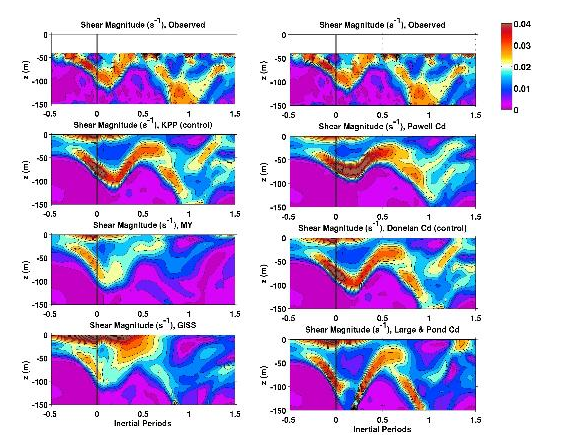Ocean Model Evaluation and Improvement for Coupled Hurricane Forecast Models
PIs: George Halliwell (NOAA/AOML)
External PIs: Lynn K. Shay (UM/RSMAS), and Benjamin Jaimes (UM/CIMAS)
This project evaluates ocean model SST forecasts under hurricane forcing with the overarching goal of improving ocean model performance in coupled hurricane forecast models. Ocean forecasts driven by imposed hurricane forcing fields are evaluated against high-quality ocean observations. The HYbrid-Coordinate Ocean Model (HYCOM) is used because it is being evaluated as the ocean component of the next-generation HWRF hurricane forecast system. The most important single factor for improving SST forecasts for hurricanes is the accuracy of initial ocean model fields with respect to both the location of ocean features and the upper-ocean temperature and salinity (density) profiles within them.
Multiple ocean analysis products produced by operational forecast centers that use HYCOM and other model type have been evaluated for overall accuracy, and also to quantify the impact of targeted airborne ocean observations on the accuracy of initial ocean fields. Recent improvements in the HYCOM ocean data assimilation system have greatly improved the accuracy of the initial fields obtained from this product. This has enabled us to begin focusing on evaluation of model numerics and parameterizations on the accuracy of model forecasts and to use these results to devise strategies for model improvement. For example, the accuracy of velocity shear profiles produced by HYCOM, which are critically important for simulating entrainment cooling of SST, has been evaluated against moored ADCP current measurements from an array that was directly struck by Hurricane Ivan (see Figure 1).

Figure 1. Time series of the magnitude of vertical shear (s-1) comparing observations from SEED ADCP mooring 9 (top left and top right) to three vertical mixing choices (left) and three wind stress drag coefficient choices (right). The combination of KPP mixing and Donelan et al. drag coefficient parameterizations produce the most realistic shear structure in comparison to observations. This is an example of how careful comparison of model to observations enables the identification of optimum parameterizations that improve ocean model performance.
Publications
Halliwell, G., L. K. Shay, S. D. Jacob, O. Smedstad, and E. Uhlhorn, 2008. Improving ocean model initialization for coupled tropical cyclone forecast models using GODAE nowcasts. Mon. Wea Rev., 136 (7), 2576–2591.
Halliwell, G. R., L. K. Shay, J. Brewster, and W. J. Teague, 2010. Evaluation and sensitivity analysis to an ocean model response to hurricane Ivan. Mon. Wea. Rev., 139, 921-945.
Jaimes, B., L. K. Shay, and G. R. Halliwell, 2011. The response of quasi-geostrophic oceanic vortices to tropical cyclone forcing. J. Phys. Oceanogr. doi:10.1175/JPO-D-11-06.1, In-press.
Shay, L. K., B. Jaimes, J. K. Brewster, P. Meyers, E. Claire McCaskill, E. Uhlhorn, F. Marks, G. R. Halliwell, Jr., O-M Smedstad, and P. Hogan, 2011. Airborne ocean surveys of the Loop Current complex from NOAA WP-3D in support of the Deep Water Horizon oil spill. In Monitoring and Modeling the Deepwater Horizon Oil Spill: A Record-Breaking Enterprise, Liu et al., Eds. AGU Monograph Series, In-press.